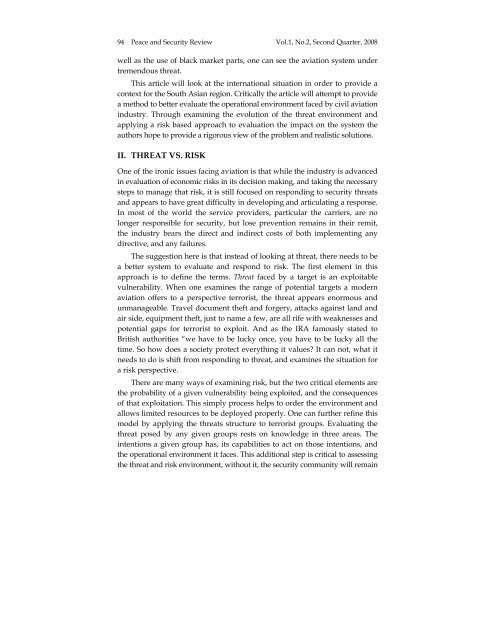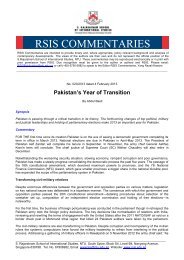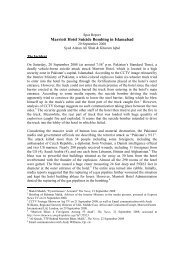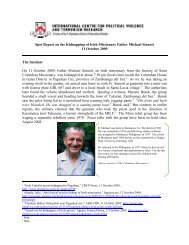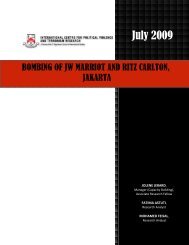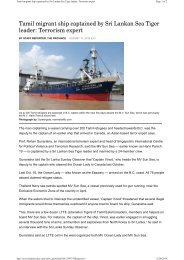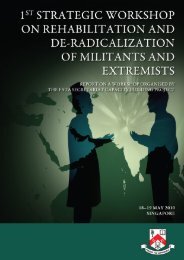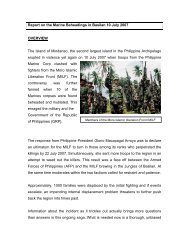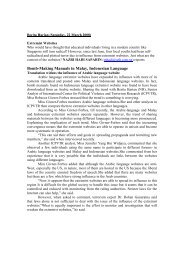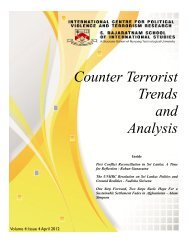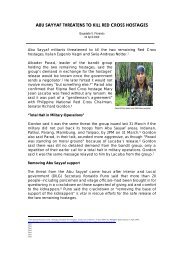Peace and Security Review, Vol.1 No. 2 - International Centre for ...
Peace and Security Review, Vol.1 No. 2 - International Centre for ...
Peace and Security Review, Vol.1 No. 2 - International Centre for ...
You also want an ePaper? Increase the reach of your titles
YUMPU automatically turns print PDFs into web optimized ePapers that Google loves.
94 <strong>Peace</strong> <strong>and</strong> <strong>Security</strong> <strong>Review</strong> <strong>Vol.1</strong>, <strong>No</strong>.2, Second Quarter, 2008<br />
well as the use of black market parts, one can see the aviation system under<br />
tremendous threat.<br />
This article will look at the international situation in order to provide a<br />
context <strong>for</strong> the South Asian region. Critically the article will attempt to provide<br />
a method to better evaluate the operational environment faced by civil aviation<br />
industry. Through examining the evolution of the threat environment <strong>and</strong><br />
applying a risk based approach to evaluation the impact on the system the<br />
authors hope to provide a rigorous view of the problem <strong>and</strong> realistic solutions.<br />
II. THREAT VS. RISK<br />
One of the ironic issues facing aviation is that while the industry is advanced<br />
in evaluation of economic risks in its decision making, <strong>and</strong> taking the necessary<br />
steps to manage that risk, it is still focused on responding to security threats<br />
<strong>and</strong> appears to have great difficulty in developing <strong>and</strong> articulating a response.<br />
In most of the world the service providers, particular the carriers, are no<br />
longer responsible <strong>for</strong> security, but lose prevention remains in their remit,<br />
the industry bears the direct <strong>and</strong> indirect costs of both implementing any<br />
directive, <strong>and</strong> any failures.<br />
The suggestion here is that instead of looking at threat, there needs to be<br />
a better system to evaluate <strong>and</strong> respond to risk. The first element in this<br />
approach is to define the terms. Threat faced by a target is an exploitable<br />
vulnerability. When one examines the range of potential targets a modern<br />
aviation offers to a perspective terrorist, the threat appears enormous <strong>and</strong><br />
unmanageable. Travel document theft <strong>and</strong> <strong>for</strong>gery, attacks against l<strong>and</strong> <strong>and</strong><br />
air side, equipment theft, just to name a few, are all rife with weaknesses <strong>and</strong><br />
potential gaps <strong>for</strong> terrorist to exploit. And as the IRA famously stated to<br />
British authorities “we have to be lucky once, you have to be lucky all the<br />
time. So how does a society protect everything it values? It can not, what it<br />
needs to do is shift from responding to threat, <strong>and</strong> examines the situation <strong>for</strong><br />
a risk perspective.<br />
There are many ways of examining risk, but the two critical elements are<br />
the probability of a given vulnerability being exploited, <strong>and</strong> the consequences<br />
of that exploitation. This simply process helps to order the environment <strong>and</strong><br />
allows limited resources to be deployed properly. One can further refine this<br />
model by applying the threats structure to terrorist groups. Evaluating the<br />
threat posed by any given groups rests on knowledge in three areas. The<br />
intentions a given group has, its capabilities to act on those intentions, <strong>and</strong><br />
the operational environment it faces. This additional step is critical to assessing<br />
the threat <strong>and</strong> risk environment, without it, the security community will remain<br />
<strong>Vol.1</strong>, <strong>No</strong>.2 2008 pp.95-114


